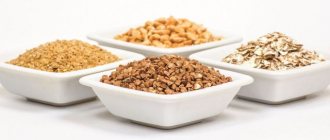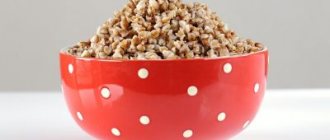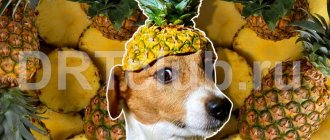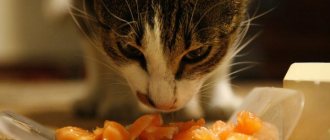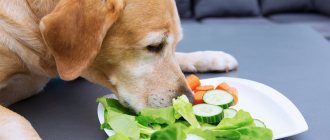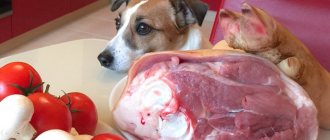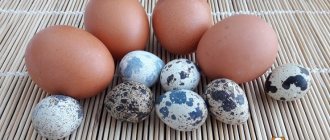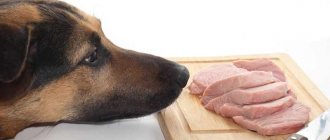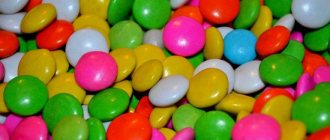Taking care of pets first of all means proper nutrition. Diets for dogs and cats are available in a wide range of pet stores, however, some owners prefer to feed the animals themselves.
Porridges are useful as a source of carbohydrates and macroelements. Despite this, only grains suitable for dogs are used in cooking. Not every grain is beneficial; some, on the contrary, can have harmful effects.
- 1 Mr. Tail recommends: the benefits and harms of cereals for dogs
- 2 What cereals can dogs eat?
- 3 What cereals should dogs not eat?
- 4 How to cook porridge for a dog
- 5 Cereals for different dogs 5.1 Puppies
- 5.2 Adults
- 5.3 Pregnant and lactating females
Mr. Tail recommends: the benefits and harms of cereals for dogs
In order to maintain the health of your pet, it is recommended to study all cereals, as well as their effect on the animal’s body. It is important not to forget that dogs are carnivores, and they need as much meat and vegetables as possible, and the carbohydrate component should not exceed 15-20% of the serving.
Porridge mixed with meat and fish products has a positive effect on the dog's health. Let's consider the effect of cereals on the body, what problems cereals will help solve:
- The product gives a feeling of fullness and the animal needs less food, which is very important for overweight animals.
- Microelements in cereals can improve immunity, strengthen bone structure, and have a positive effect on the cardiovascular system.
- In case of poisoning and intoxication, adding certain types of cereals to the diet helps the dog cope with the disease.
- After diseases of the digestive system, porridge quickly returns the animal to a normal rhythm of life.
- Cereals are a rich source of vitamins and microelements; components such as silicon, magnesium, zinc are practically absent in meat products.
Despite the above advantages, porridges also have disadvantages:
- Some types of cereals are not digestible due to the lack of necessary enzymes in dogs.
- Allergic reactions in pets are common.
- Wrong diet choices and excess carbohydrates lead to digestive disorders.
- Poorly prepared and incorrectly selected cereals can become a source of various types of dysfunction.
In order to provide your dog with a healthy diet, you need to know exactly what effect cereals have on the body and how they should be prepared.
What can you cook with - recipes
The owner must know how to cook porridge correctly so that it does not harm the body. Salt and spices are prohibited. It is recommended to add vegetable oil to the porridge. It is better to cook a mixture of cereals. For example, rice leaches calcium, so it is cooked with millet or buckwheat. Vegetables, fruits, and fermented milk products are added to porridges.
It is not recommended to cook cereals in fatty meat broth, as it puts additional stress on the liver. You can take water, vegetable broth or half the meat broth mixed with water. Meat should be purchased of high quality; sometimes it is replaced with offal. They are boiled in a separate bowl and mixed with porridge immediately before serving.
Some dog owners boil meat products and freeze them along with the broth. In this case, you need to defrost it and cook the cereal.
Boil the by-products well before serving.
As for vegetables, it is healthier to take carrots, zucchini, beets and onions. They need to be simmered until completely softened; you can also add a few raw pieces.
Porridge with meat and vegetables
Ingredients:
- 1 kg of meat (depending on the weight of the dog);
- water;
- 130 g rice cereal;
- 1 carrot;
- 0.5 zucchini.
The meat is boiled well in water, pulled out and left to cool. The washed cereals are placed in the broth (a little salt is allowed) and, stirring constantly, cook. When the broth boils, add finely chopped vegetables. Add chopped meat, a little herbs and vegetable oil (to taste) to the cooked porridge. Serve the porridge warm.
Porridge with trimmings and vegetables
Ingredients:
- 1 kg beef trimmings;
- 0.5 cups rice;
- carrot;
- zucchini;
- pumpkin;
- cucumber;
- bell pepper;
- greenery;
- vegetable oil.
Beef trimmings are placed in boiling water (this way it retains vitamins better), after boiling, cook for about 20 minutes. At this time, rice is boiled separately. Before serving, rice, broth, vegetable oil and meat are mixed, adding fresh vegetables.
Multikasha
Ingredients:
- 300 g meat;
- 300 g of lung or heart;
- 0.5 cups rice;
- 0.5 cups buckwheat;
- carrot;
- 0.5 zucchini;
- 0.5 pepper;
- tomato;
- greenery;
- vegetable oil.
The meat is boiled for 20 minutes, the resulting broth is filtered. Vegetables and lung (heart) are chopped. The ingredients are placed in the broth and cooked for another 20 minutes. Finely chopped herbs and vegetable oil are added to the finished porridge.
Chicken with rice
Ingredients:
- chicken;
- rice cereal;
- carrot.
Cut the chicken, add water and cook until done. Boil rice in another bowl. The finished chicken is deboned and ground into minced meat. Grate carrots. All ingredients are mixed, vegetable oil is added.
Apple with oatmeal
Ingredients:
- apple;
- 1.5 cups flour;
- 1 cup oatmeal;
- 0.5 glasses of water;
- 2 tbsp. l. honey
The apple is grated, water, honey and oatmeal are added. Mix everything thoroughly and add flour. The resulting dough is rolled out like a flat cake, laid out on parchment, and cut into pieces. Bake in the oven for about 30 minutes.
Porridge with fish and vegetables
Ingredients:
- fish;
- buckwheat grain;
- pumpkin;
- water.
The fish is placed in boiling water and cooked until tender. Then it is taken out, cleaned of bones, and crushed. Place cereal into the resulting broth and boil it. 5 minutes before readiness, add chopped pumpkin to the porridge. Add fish and vegetable oil to the porridge that has cooled to room temperature.
Porridge "Health"
Ingredients:
- take rice, egg, buckwheat and oatmeal in equal proportions;
- chopped meat;
- powdered milk;
- water.
The cereals are washed, mixed and poured with boiling water. Bring to a boil, remove from heat, leave for about 12 hours (it is better to cook in the evening). The minced meat and milk powder (diluted with water) are mixed, added to the cereals and put in the oven to simmer for two hours.
What grains can dogs eat?
Cereals and cereals are varied and it is difficult to choose the right one, especially considering the fact that not every owner knows the properties of the product. Let's look at “good” cereals and their effect on the pet’s body:
- Buckwheat is a dog's best friend. This is a magic cereal that can be included in the diet from the first months and given throughout life. It is even suitable for daily feeding, but this is not advisable. So, a dog eating buckwheat porridge is protected from allergies, develops well, does not gain excess weight, and receives a healthy amount of protein and vitamins. This product allows you to eliminate vitamin supplements.
- Oats - in any form, in grains or flakes, are beneficial, but you should be careful, such porridge is not suitable for some dogs. The first time, add a small amount to the meat and observe the pet’s reaction. If there is no allergy, then you can use the product as a rehabilitation food after illness or for stomach upsets to reduce pain. The product is rich in microelements, vitamins and antioxidants, which generally has a positive effect on the dog’s body.
- Rice is a dog's doctor for poisoning and diarrhea. It helps remove intoxication products from the body, while nourishing with vitamins and microelements. For irritable bowel syndrome, sticky porridge helps relieve pain by enveloping the walls. It is worth giving rice infrequently, in small portions. The product is contraindicated in animals with diabetes and excess weight. When choosing cereals, they give preference to unpolished grains.
- Wheat is a grain that most owners keep on hand and constantly prepare for dogs, but it is not very healthy. It should be given in minimal quantities, and only to absolutely healthy dogs, not prone to obesity and constipation. The essential substances contained in this cereal are difficult to digest, but do not clog the intestines. It is better to combine porridge with vegetables, this way more vitamins enter the body and significantly reduce the risk of constipation.
All other grains are contraindicated in dogs or are prescribed in rare cases as medications.
Cereals of the first group, which should be preferred
Rice
Rice contains vitamins B and E. It is rich in microelements: calcium, iron, zinc, copper, magnesium. Rice is an absorbent; it absorbs toxic substances from the gastrointestinal tract and removes them from the body. It has enveloping and astringent properties. Rice decoction helps with diarrhea.
Before cooking, rice should be rinsed in cold water and cooked until tender. If the rice porridge turns out thick and sticky, you can add a spoon of vegetable oil.
Unpolished rice has more valuable qualities. Advantages over polished:
- protein content is 3 times higher;
- contains dietary fiber, which improves immunity;
- contains fatty acids (lipids);
- low starch content.
Unpolished rice takes a little longer to cook, so before cooking it needs to be soaked for 1-1.5 hours.
Constantly eating rice porridge can cause constipation in your dog. To avoid this, it is better to mix rice with buckwheat in a 1:1 ratio.
Buckwheat
The advantages of buckwheat are that after heat treatment it retains all its beneficial properties. Contains vegetable proteins, vitamins B and E, iron, magnesium, calcium. Uncooked cereal is preferable.
Buckwheat porridge improves metabolism, the cardiovascular system, and improves immunity. The presence of calcium helps strengthen bones and teeth. It is low in calories, which makes it indispensable when preparing food for sedentary animals or for those who need to lose excess weight.
Cook buckwheat in water, in a ratio of 1:1.5, until crumbly. You can pour hot water over the cereal and leave it overnight. In the morning the porridge will be ready.
What cereals should dogs not eat?
The negative effect of cereals on the body of dogs has not been scientifically proven, however, there are a number of cereals that should not be given to animals. Let's look at them and their effect on the dog's health:
- Millet is poorly digestible and clogs the intestines. There is no benefit from it, it only increases the likelihood of allergic reactions.
- Semolina - there is no benefit to the croup for either animals or humans. No vitamins, no minerals, just heaviness in the stomach and a large amount of carbohydrates. Sometimes the product is prescribed by veterinarians for weight gain in premature puppies or in the presence of inflammation in the gastrointestinal tract.
- Pearl barley is processed barley. Porridge is rich in vitamins and microelements and is very beneficial for humans. In dogs, it is practically not absorbed, causing digestive disorders and allergies.
- Barley porridge was included in the “bad” list due to the inconvenience of feeding. In order for the animal to benefit, it is necessary to feed only fresh cereals mixed with other “good” cereals. A completely cooled mass is dangerous for dogs; it falls into the stomach in a useless lump, clogging it and disrupting digestion.
- Corn is the enemy of cats and dogs. This product is not absorbed at all and forms lumps when passing through the intestines. Active animals after such porridge can get volvulus, so you should put the cereal in the far corner. This porridge is also a strong allergen, especially for cats, so owners choosing ready-made diets should be very attentive to the composition. Corn is often used to increase the calorie content of finished feed. There are dogs that absolutely love the smell of boiled cobs, and the pet’s requests are difficult to ignore; such gourmets are allowed to chew the grains, making sure that the cob remains untouched. The central part is only suitable for kindling.
- Legumes - any kind are not digestible by dogs. After eating beans or peas, the dog suffers from bloating and flatulence, while constipation occurs and the animal suffers. The maximum that is acceptable from legumes for dogs is 2-3 pods of young green peas literally once a year.
This data is very useful for beginners. You can create a list of prohibited foods and constantly use it when preparing food for your pets.
Why can't you give?
Semolina can rightfully be called a rather specific product - although it has some benefits for the body, there are also disadvantages.
- Frequently feeding a dog semolina porridge leads to excess weight gain.
- Semolina, like pasta, contains gluten, which has a cumulative effect, and if consumed excessively, it can cause severe allergies.
- Semolina can also significantly increase blood sugar levels, which makes it absolutely unacceptable for pets with diabetes.
Therefore, semolina porridge is strictly not recommended for sedentary dogs prone to gaining excess weight and predisposed to allergic reactions or autoimmune diseases (white breeds).
How to cook porridge for a dog
A lot depends on how the lunch is prepared: preservation of benefits, digestibility for the animal, taste characteristics. For example, any cereal, when cooled, becomes useless, so it is better to throw away the leftovers.
Broths prepared with meat can be stored for up to 2 days and no more. Later they lose their beneficial properties and there is a risk of poisoning.
Cooking porridge for dogs has several rules that every owner should know:
- By soaking buckwheat and rice before cooking, they improve the properties of the cereals and pour cold water for 20 minutes.
- Sticky porridges are cooked with a little oil, then they turn out crumbly and tasty.
- Oatmeal goes well in addition to other cereals.
- Animals should not cook milk porridges; they are poorly digestible. It is best to cook food in broth or plain water.
- The pan in which food is stored must be tightly closed to prevent the entry of foreign objects.
It is impossible to keep food in the refrigerator for a long time; it is optimal to cook it for one meal, for small dogs it can be done for a day.
Why is it better to cook porridge in water?
Cereals are quite heavy food for a dog’s stomach to digest, so they need to be cooked in water. If you cook porridge with meat broth or milk, the dish will lose nutritional value. It will become difficult to digest and will not bring anything useful; its digestion will become stressful for the animal’s body.
Subsequently, undigested fats, minerals and other substances will cause damage to the dogs’ internal organs. Sometimes due to this type of diet, dogs develop gastritis and other stomach problems.
A third of a dog’s diet should consist of cereal
Cereals for different dogs
In addition to knowledge of the properties of cereals and methods of their preparation, you should especially carefully select the diet according to the age and health of the animal. For example, something that will benefit a puppy may be dangerous for an adult dog.
So, when choosing products for dogs, all aspects are taken into account, including weight, age and even breed, because there are individual characteristics of artificially bred forms. For example, the Basset Hound is a vegetable dog and its diet should contain a range of fresh foods. Many varieties have such features; they need to be known and taken into account when creating a diet.
Puppies
Small dogs need special attention and nutrition; their children's bodies still digest lactose, so porridge is cooked in milk. Semolina is the best way to gain weight, so it would be appropriate here. It is given from a month onwards to babies with developmental delays.
It is important not to overdo it; as soon as the dog begins to gain weight, it is switched to a less calorie diet.
It is recommended to gradually introduce cereals into the diet, in particular buckwheat and rice, and add the rest little by little over time. It is advisable to eliminate dairy products by 6 months. Porridge should be cooked in meat broth with the addition of vegetables and small pieces of meat. A one-year-old dog is switched to adult food.
Adults
Dogs that are a year old or more eat everything. Their diet should be varied and balanced. Carbohydrates and proteins are combined in a ratio of 3:7. Dairy products are completely excluded and begin to reappear in the dog’s life in old age.
Carbohydrates are strictly prohibited for elderly animals, so cereals are removed and replaced with cottage cheese and vegetables. Fermented milk products help strengthen bones, and vegetables improve digestion and saturate the body with vitamins.
Pregnant and lactating females
During pregnancy and feeding of offspring, vitamins and minerals in the dog’s body are not restored, so buckwheat and rice are cooked in milk. Mix a few tablespoons of oatmeal into the cereal. It is also good to feed the bitch with cottage cheese and kefir, and diversify the food with vegetables.
The best meats are rabbit and beef.
conclusions
What grains can be cooked for dogs? Porridge with meat or fish plus vitamin supplements is great for all age groups and dog breeds. Not all cereals are equally healthy. Wheat and barley groats are allergenic. They contain a lot of gluten. Corn is used only as an additive at a level of 10-15%. Rice, buckwheat and millet (use only in properly prepared form) are hypoallergenic. If we talk about what kind of cereal a puppy can eat, then it’s better to limit it to rice. The share of cereals is on average 30% of the diet. Peas and other legumes are not suitable for feeding dogs. Semolina is used for puppies at the initial stage of complementary feeding and in the treatment of adult dogs.
Please follow and like us:
Nikitin Sergey
I write about dogs based on the experience and knowledge gained during my studies as a veterinarian, work in my specialty, and simply from observing my pets.
What cereals can be given to dogs of small and large breeds
For some reason, people very often believe that the choice of cereals is different for large and small breeds. This is wrong. Buckwheat and oats (rolled oats) are best suited for the diet of both large and small dogs. But it is better to avoid corn, semolina and some other cereals. We have already written about all this in the relevant sections of the article.
From the author. We feed our Irish Setter exclusively natural food. For breakfast we give cottage cheese and kefir. And for dinner, porridge and meat, usually rolled oats, less often buckwheat.
Do I need to salt the porridge?
Can dogs have milk: why not?
Dogs get enough salt from natural foods in their diet. Unlike sugar, this seasoning is vital for the proper functioning of internal organs. The nervous system of animals also needs a daily dose of sodium chloride.
It is not recommended to add pure salt to porridge, provided that the pet has a varied diet. With a meager menu, there is a lack of certain minerals; in this case, adding a very small amount of salt is allowed.
Norms of cereals in the diet of dogs
Calculation of nutritional allowance depends on the size and weight of the dog, its age and state of health. The diet for special animals is prepared by a veterinarian, who also prescribes dosages. For healthy dogs, the daily portion size is calculated based on 3% of the total body weight. That is, if a pet weighs 10 kg, its daily portion of food should be 330-350 grams, food is divided into 2 meals.
Porridge should not exceed 25-30% of the diet. Accordingly, for a medium-sized dog you will need no more than 100 grams of cereal per day.
Features of dog digestion
Based on the type of digestive system, dogs are classified as omnivores. Over 10,000 years of living next to humans, she learned to digest sugar, fiber and starch. This fact is confirmed by genetic studies.
Peculiarities of digestion depend on the climate, geography and culture of the people in whose surroundings the breed was formed, and other factors. For example, many European Shepherds have survived for centuries on a meager, low-protein diet. In Serbia, herding dogs were fed mainly with cornmeal and semolina porridge, a small amount of meat, offal, and vegetables. Not a single native Japanese breed can live happily on such a diet; its digestive system is tuned to meat, fish, rice, and vegetables.
Not all cereals are equally healthy
It is impossible to definitively answer the question of which porridge is best for dogs. There are general recommendations regarding feeding, but first of all you need to take into account the individual digestive characteristics and taste preferences of your pet. The digestibility of porridge can be judged by the amount of undigested cereal in the feces. If there is a lot of it, it is better to discard the product. Also, cereals should be immediately removed from the diet if they cause digestive upset.
What kind of porridge can be given with caution?
Wheat groats - suitable for feeding only in the form of chaff or flakes. It is characterized by a rich composition and average digestibility. It is not completely digested. Suitable for feeding adult healthy dogs. Not recommended for animals suffering from obesity, diabetes, or gastrointestinal problems.
Semolina is well digestible. It contains iron, gallium, but trace elements and vitamins are not included in the composition. Semolina is usually introduced into the diet of puppies and very active dogs to meet their energy needs.
Pearl barley and barley - contain a lot of fiber, folic acid and iron, good for hematopoiesis and peristalsis. Digestibility is relatively low, but cereals can be recommended for obesity and constipation in combination with rice or buckwheat.
